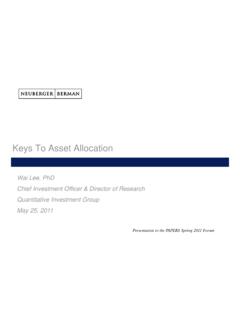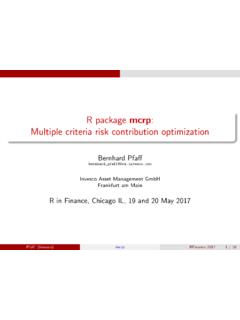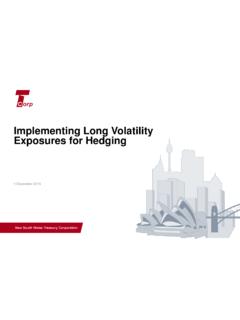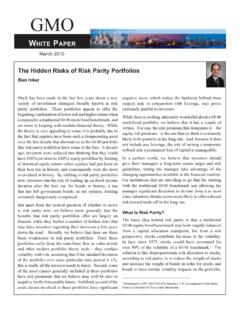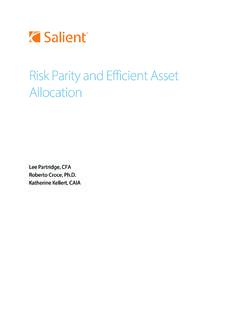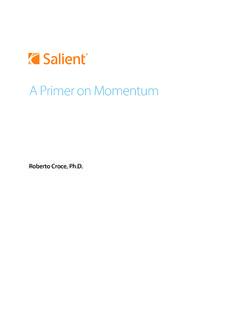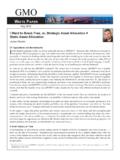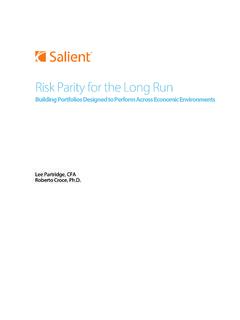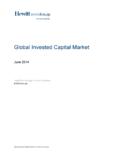Transcription of Factor Investing: A reliable source of excess returns?
1 Factor Investing: a reliable source of excess returns ?Dr. Benedikt Henne, CFAM anaging Director,Co-CIO AllianzGI Systematic Equity Dr. Klaus TeloekenManaging Director,Co-CIO AllianzGI Systematic Equity 2 Executive Summary In this thought piece we discuss frequently asked questions about Factor investing such as how did the current strong interest in the field develop? , which factors to choose? , does data mining overstate Factor returns? , will returns be persistent or arbitraged away? , are factors relevant to all investors? , is Factor timing an option? and how should factors be combined?
2 The key insights are: Factor investing already has a long history but many asset managers have only recently launched institutional investors have noticed that a large part of their relative returns can be explained by Factor returns even if they did not allocate to Factor products a consequence, they have embraced Factor investing and regained control over their Factor exposures by allocating explicitly to factors and by managing the associated investing will not go away as an investment theme since factors carry risk premiums that cannot be arbitraged away. The choice of factors is pretty straightforward as there is only a limited number of risk premiums available, the more challenging part is the choice of risk management measures when combining A short history of Factor investing : how did the current strong interest in the field develop?
3 Factor investing begins with a very basic question: where do extra returns within equities come from? . The Latin word Factor means who/which acts , so Factor research asks who s done it, which forces drive extra returns? . One might think that the answer to such a simple question is an easy one: the portfolio outperforms because the portfolio manager picked the right stocks. But simple questions tend to have more subtle answers than initially thought. Consider the famous thought experiment by the finance professor Burton the experiment, a chimpanzee throws darts at the stock listings in the Wall Street Journal.
4 If someone were to read the names of the stocks hit by the darts and create a portfolio of fifty names, equally weighted at 2% each, the result would be a portfolio that outperforms the broad market after ten years. The portfolio would certainly have a high tracking error and show large swings of over- and underperformance, but in the long run it would work. If you had not known that the chimpanzee had picked the stocks, you might have been impressed by the stock-picking skills of the manager . But as we know, there was no manager; there was only a chimp throwing darts at random. So imagine replacing the chimp with a random number generator and repeating the experiment on a computer several thousand times.
5 As with the chimp s portfolio, the vast majority of the computer s randomly chosen portfolios would also outperform. Clearly, then, this outperformance cannot be explained by stock picking. How about the role of the weighting scheme? Instead of using a 2% equal weighting for every holding, we could use weights which are inversely proportional to the inverse of the volatility of stocks the so-called risk parity weighting. How would this affect results? It turns out that the randomly picked stocks would still outperform after this weighting scheme is applied. Just to play devil s advocate, one can also use the opposite of the risk parity scheme by using weights that are proportional to the stock volatilities and again one finds that the portfolios outperform in the long run.
6 So what is going on here? Why did the chimp do better than the index? To answer this question, we must take a closer look at the index. Let us assume that the chimpanzee is throwing darts at a listing of the stocks in the S&P 500 Index. The market - capitalization weight distribution of this index is highly concentrated; there are just a handful of stocks that have weights of more than 2%, with the majority weighted at less than 10 basis points each. Therefore, most of the stocks that get picked by the chimpanzee are small in the benchmark in terms of market cap size yet they get a 2% weighting in the chimpanzee s chosen portfolios.
7 For more than half of the stocks, this represents a 190-basis-point overweight or more. As a consequence, there is a strong small-cap bias in all the portfolios used in the chimpanzee experiment. The risk- parity scheme and the opposite of the risk- parity scheme, on the other hand, allocate approximately 2% weightings to stocks with average volatility. They differ in how much they allocate to stocks with above-average or below-average volatility, but they both allocate more than 10 basis points to most names which means they also create a significant small-cap bias as well as a value bias (though not necessarily at all times).
8 We see now that while the chimpanzee in a sense picked stocks, what mattered more were the exposures that implicitly resulted from the exercise. The stock pickingand the weighting schemes created almost the same small-cap and value exposures. This shows that investment styles such as value and small caps play an important role in investing even if this role is not obvious when picking stocks and attaching weights to them. Value and small-cap exposures are examples of the so-called Factor exposures that are the driver behind the relative performance of most active managers. The existence of these factors is well-documented in academic literature; these factors exist in all investment regions of the world and they work over extended time spans.
9 Here is a ver y small sample of the relevant literature: Basu (1977) showed that stocks with a low price- to-earnings ratio outperformed stocks with a high price-to-earnings ratio on the New York Stock Exchange. Banz (1981) described the size effect , smaller companies outperforming larger ones. Jegadeesh and Titman (1993) showed that stocks with strong price momentum tend to continue to lead the market. Yet despite the existence of a wealth of academic research covering these factors , there is still disagreement over the true nature of these drivers. Are the returns ultimately driven by investor behavior and psychology?
10 A sign of market inefficiency? Are the returns compensation for running greater business risks , in line with market efficiency? Or is there more than one answer? 4 The answers to those questions are relevant because portfolio construction will differ depending on the true nature of the drivers. If they are caused by inefficiencies, they can only work as long as the market stays inefficient and the aim of portfolio construction will be to condense as much inefficiency as possible in a concentrated portfolio. If they are caused by the presence of risk premiums, the ultimate aim of portfolio construction will be to diversify among the risk premiums and to create a broad and accurate representation of the factors that still works when markets are perfectly at Allianz Global investors believe that investors are well advised not to underestimate the efficiency of the markets and to rather err on the side of caution.

